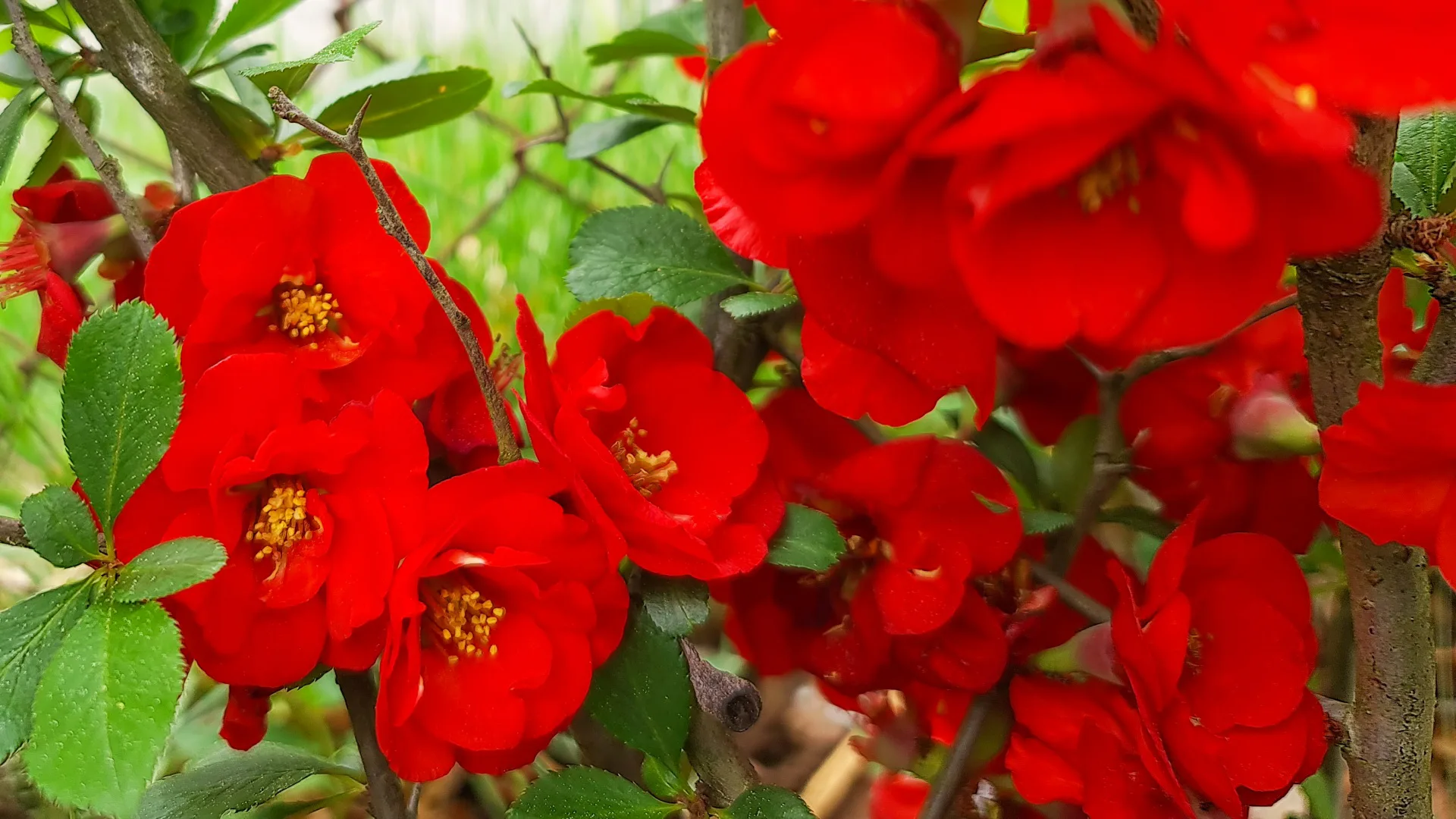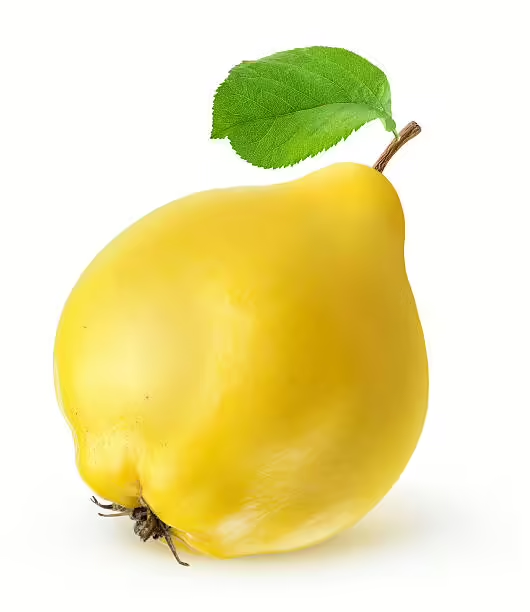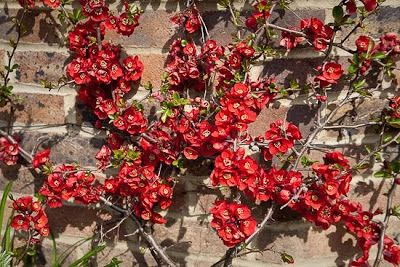
Written by s • Get to Know the Quince
If you haven’t smelled the fruit of the quince, you have missed out on something beautiful. These strange hard fruits are renowned for their perfume, and were first used in the Middle East to make a scent called Melinum. Today you can still find them in perfumes, from Chanel’s Chance Eau Tendre to Britney Spears’ Fantasy. The aroma rising from the ripe fruit has been described as ‘guava-like’, or ‘between apples and pears’, but the fruit does need to be ripe, and some people are sadly unable to smell it at all. The fruit might look like a knobby pear, but raw it is hard, sour and astringent, so don’t be tempted by that delicious aroma to take a bite. Cooked it is something different again, making delicious preserves, pastes and jellies, that can be used like jam or served with cheeses and cold-cuts. But this is a gardening site, so what about quince in the garden? Let’s explore, because there is a lot to know and enjoy about the quince.
The first ‘fun fact’ is that there are three distinct plants commonly called quince. The first is best called just ‘quince’, and comes originally from the Middle East, and the lands between Armenia and Afghanistan. The second is the ‘Chinese quince’, and the third is the ‘flowering quince’, both from Asia. Let’s take a look at them.
Quince

Growing all across western Asia, usually on mountain slopes and around the edges of forests, that is where you might find wild plants of Cydonia oblonga, the most ancient of the fruits called quince. Grown by the Greeks and Romans, this tree is a relative of apples and pears and grows to about 20 feet tall and wide. The flowers are like large apple blossoms, either pink or white and about 2 inches across. A tree in bloom is ornamental, and by fall slightly strange, pear-like fruits 3 to 5 inches long will develop. These are yellow when ripe, and improve in flavor and aroma with frost, so don’t be in a hurry to harvest them. A quince tree is hardy, and needs a combination of cool winters (below 45oF) and hot, dry summers and falls to grow and fruit best. There are many varieties, but most are rare and hard to find, and trees grown from seed are almost always of poor quality.
Chinese Quince
A much later arrival, and rarely seen outside southern Europe and the Far East, the fruit of the Chinese quince is very similar to the ‘true’ quince, but easily distinguished by the tree’s serrated leaves and single flowers (not in clusters). Called Pseudocydonia sinensis, it comes from China, where it is called mùguā (木瓜). It is also grown in Korea, and in both countries used for food and medicine. It needs similar conditions to Cydonia, and it can be grown from seed. It is rarely seen, or available, in America.
Flowering Quince
For gardens, there is no doubt that the flowering quince is the most popular, and certainly the most widely grown. The fruits are smaller and rounder, and they rarely turn yellow, but stay the color of a green apple. They are just as good for cooking, and they smell as delicious too. The bonus is the two weeks of bloom in early spring, which is often spectacular, and very welcome at a time when the garden is still sleeping. In mild areas blooms can be out before Christmas, although February is more usual. In cooler areas you should see blossoms in March or April, on the bare twigs, and among the first new leaves.
A Tale of Mistaken Identity
The first trickle of plants began to arrive in western countries from Japan in the 18th century, but the Japanese were cautious of Westerners, and early trade was difficult. In 1796 the famous botanist and explorer Joseph Banks brought plants back to England that were called Pyrus japonica. This plant was confidently believed to be the same as a plant given that name over a hundred years earlier by Carl Peter Thunberg, a Swedish botanist who lived for years in Japan, and wrote about the plants he found in a book called Flora Japonica, published in1784. Gardeners began to call it ‘Japonica’, and many color forms were developed – for a time it was hugely popular in gardens.
Even botanists can make mistakes, though, and Joseph Banks was wrong. Another flowering quince arrived in England in 1869, with red flowers, which was thought to be something new, and named Cydonia maulei. Years went by until the mistake was discovered, and it was realized that ‘Cydonia maulei’ was really Thunberg’s original ‘Pyrus japonica’. By then these plants had been given their own new group – Chaenomeles – so that plant became Chaenomeles japonica, and the older ‘Japonica’ had to be re-named, and became Chaenomeles speciosa. Confused yet?
New Varieties are Created
Today often called Japanese flowering quince, Chaenomeles speciosa is having a revival, bringing together interest in heirloom plants, growing food at home, and growing plants that are easy and low-maintenance. New varieties are available, including ones with double flowers created by Dr. Thomas G. Ranney, a Professor of Horticultural Science at North Carolina State University. Released as Double Take Orange™, Double Take Scarlet™, and Double Take Pink™, these have large blooms with many petals, and look like clusters of small roses – truly lovely creations.
Hybrids As Well
The two closely-related species of flowering quince can be crossed together, and hybrids have been created by chance or intentionally. These are called Chaenomeles x superba, and these plants, often with red flowers, are sometimes available. If you want to grow quince for cooking, then it is best to avoid hybrids and double-flowered forms, because these rarely produce any fruit.
Growing Quince

A great way to grow the flowering quince is on a wall or fence. Planted out in the garden it often forms a sprawling shrub with long branches, but planted at the bottom of a sunny surface it can be tied in and trained a little to cover that wall in beauty, or glossy green, for much of the year. This is also great for cooler zones, because in this drier and warmer spot they will bloom earlier and with great enthusiasm.
When blooming ends you have a choice to make. If you don’t want fruit you should prune at this time, cutting back the stems to just a few inches, so that lots of short branches, full of flower buds, will develop. This often means removing potential fruits, though. If you want fruit then delay pruning until you see them developing, and leave as many as possible, pruning back after you harvest your delicious, aromatic crop.
*** To check the availability of any of the plants mentioned here, go to our Home Page, click on the ‘Search’ button in the upper right, and type in your choice – both common names and botanical ones will work. If, sadly, you find the item sold out, click on the ‘notify me’ box beside the size you want, and you will get an email the moment that plant is available again – it’s easy. Sometimes we describe plants that haven’t arrived in stock yet, so check back later if you can’t find them.





